It is not difficult to fall in love with calathea since this gorgeous tropical plant, with immensely decorative leaves, will enchant you at first sight! Let’s discuss the different types of calathea.
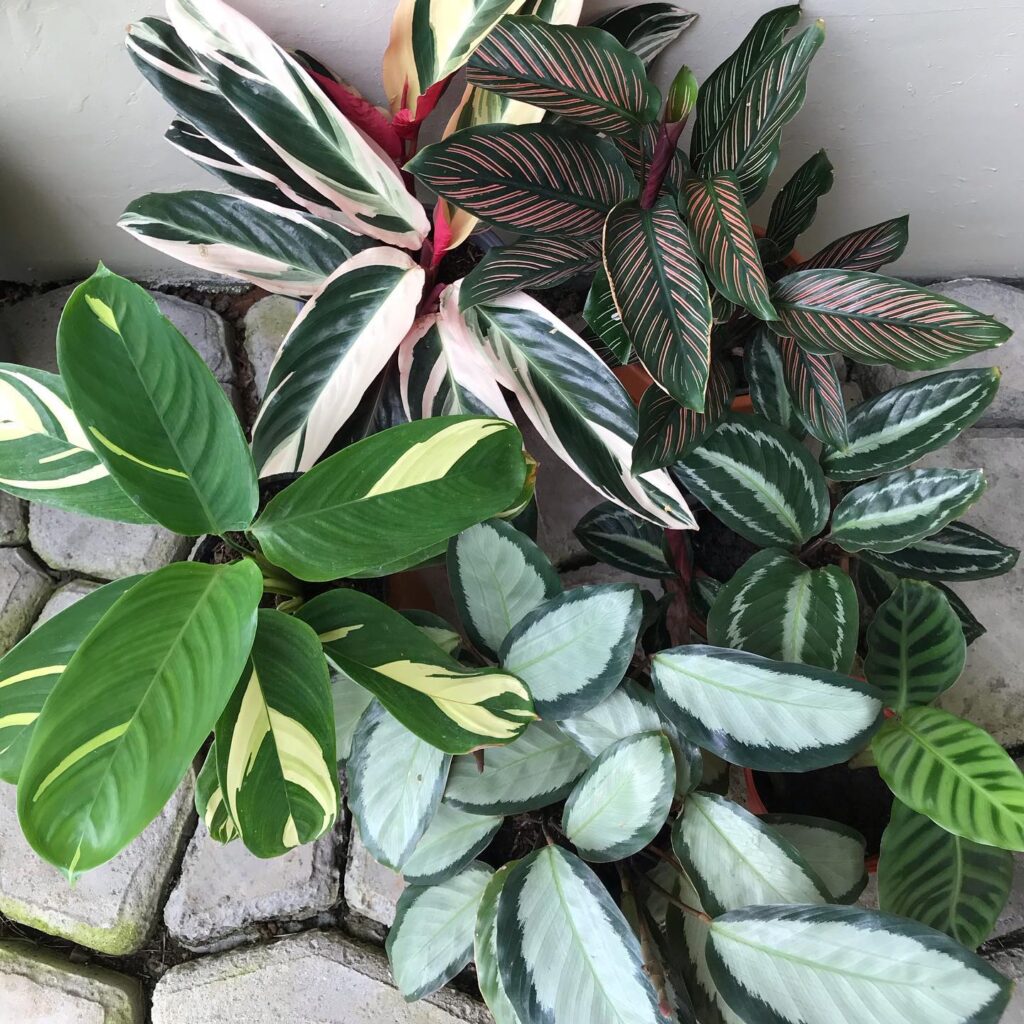
Native to Brazil and other tropical South American countries, calathea brings the aura of distant, shady, and mysterious rainforests into your home.
What is the Calathea Plant?
Calathea is evergreen, herbaceous, flowering perennials with rhizome roots and highly decorative foliage of the same-named genus in the Marantaceae family.
Its botanical name comes from the Greek word calathus or basket, and the locals in the Amazon jungle still use the leaves of indigenous calathea to wrap fish and make holders and vessels.
The genus includes about 200 species, which can grow from one to three feet in height and width, but not all are prized and sought-after houseplants.
Yet, you can choose from more than 60 varieties of beautifully painted calathea plants thanks to crossbreeding and cultivation.
Their main trump card, variegated leaves on long stems, often with deep purple underneath, are real masterpieces of harmony, color and elegance, so it is no wonder that calathea are among the most popular indoor plants worldwide.
RELATED: 20 Types of Calathea Plants that You Should Have in Your Garden
Is Calathea a prayer plant?
Plants from the genera Calathea, Stromanthe and Marante form a group of plants in the same family, often called prayer-plants.
Namely, the plants from mentioned genera raise or fold the leaves as in prayer in the evening, with the withdrawal of natural light, and open them again with the birth of a new day.
Scientifically, this spectacular and unique phenomenon is called nyctinasty and involves the reaction of foliage to light reduction.
How to care for calathea
Sometimes you can come across contradictory information about growing calathea. Some describe it as a demanding houseplant, while others state that it is easy to grow and recommend it to beginners. The truth is, as always, somewhere in the middle.
Humidity
Calathea is a tropical plant that grows in a warm and humid environment. It means more humidity in the air than usual in the northern hemisphere.
In other words, you can’t bring it into the house and leave it to suffer in an environment of an average of 30-40% humidity, which is far from the required 60-80%. The plant will react to the lack of moisture with dry brown, brittle leaf tips. Fortunately, this is an issue that is easy to solve.
- Regularly spray the leaves with lukewarm stagnant water, best in the morning. Excess water trapped in the evening folded leaves can cause fungal diseases and rot.
- You can place the plant on a pebble tray, and the water that evaporates from it will change the micro climatic condition in the immediate plant’s surroundings.
- Another option is to use humidifiers, simple gadgets that regulate humidity in the air. It is a practical solution, especially if you have several tropical plants in the same space.
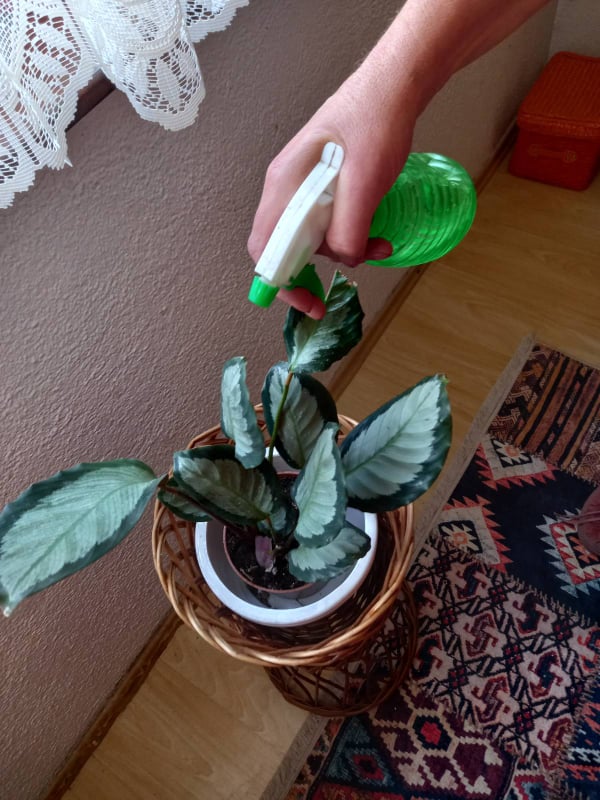
Watering
In addition to moisture in the air, calathea also likes moderately moist soil. Water it with small amounts of water every few days, from spring to autumn and once a week in winter. Always allow the soil to dry on the surface before the next watering.
Temperature
The ideal temperature for growing calathea ranges from 65 to 80 F. It can withstand slightly lower temperatures in winter but never below 50 F.
Soil
Calathea likes slightly acidic, nutritious and well-drained soil in which water does not stay too long. You can grow it in ready-made mixtures for calathea or make a blend of a standard house plant substrate to which you will add a little humus and sand.
Choose a wide pot with drainage holes for planting since the root spreads horizontally. Therefore, a deep and narrow flower pot is not suitable.
Light
Calathea prayer plant grows best when given a lot of bright indirect light protected from direct sunlight. For example, you can place it next to the east or west window, and it will thrive in indirect light next to the large north window.
List of 15 Popular Calathea Plants
1. Calathea Zebrina – Zebra Plant
Calathea zebrina, also called Calathea Bella, grows between two and three feet tall and has 10-12 inch long elliptical, velvety leaves that grow almost horizontally on long, stiff stems.
The leaf blade is emerald bright green, interspersed with noticeable dark green stripes that extend from the central nerve to the edges of the leaf.
When the Calathea Zebrina folds the leaves in the evening, it shows an intensive purple leaf’s backside.
It is a long-lived but slow-growing species, so do not expect more than five or six new leaves a year!
Mature plants bloom with inconspicuous purple or tubular flowers on tall stems. However, indoor plants are not likely to bloom.
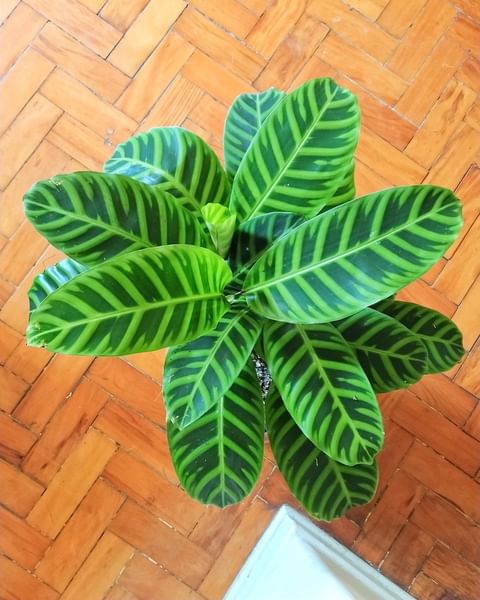
Yet, the lovely variegated leaves in the zebra pattern, not the flowers, are the reason for the popularity of this plant.
2. Calathea Orbifolia – Round Leaves Calathea
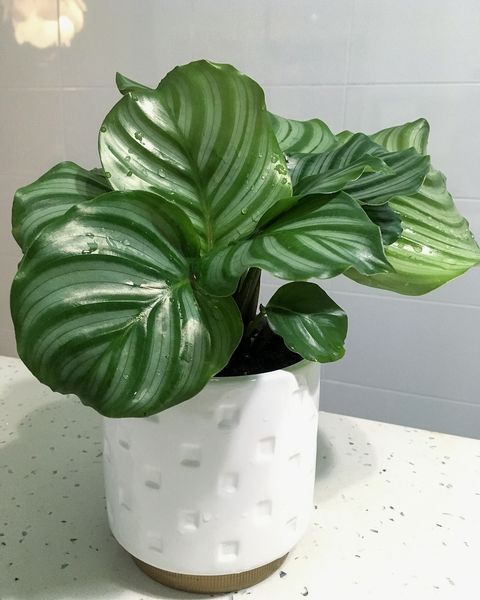
Unlike most varieties, Calathea Orbifolia has large 10 inches or more large, leathery, round leaves with symmetrical light green, creamy or silvery and dark green stripes of equal width.
The plant is native to Bolivia, and as a fast-growing species, it quickly reaches 2 feet in height, sometimes even more. It quickly grows up to two inches. However, as it has large leaves, it is usually wider than two feet.
The richly leafy and extremely exotic Calathea Orbifolia is particularly sensitive to inadequate lighting. Therefore, you could place it in indirect light, as too strong, direct sunlight causes fading of the leaves.
Due to the shape of the leaves, the common name is Round leaf calathea, but sometimes due to the color of the leaves, you can also find it under the name Lemon-lime calathea.
3. Calathea White Fusion
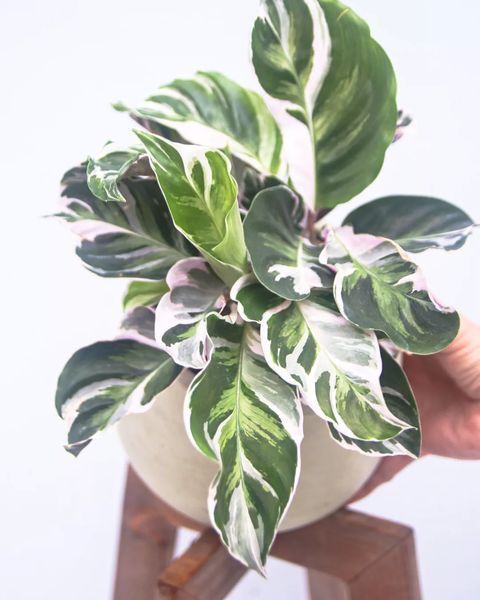
Rare and beautifully painted Calathea White Fusion is a stunning addition to any ambiance. Each leaf of this beautiful plant is uniquely a masterpiece of white, dark, and bright green patterns resembling watercolor. If you add the lilac purple back of the leaf, you get an almost unreal beautiful plant.
The plant grows slowly and usually reaches between one to one and a half feet in height and one foot wide. Calathea White Fusion prefers filtered, indirect light and grows well next to the north or east window.
Although it is not the easiest plant to grow and can be picky and demanding, a diva among calathea plants is worth the extra effort. It is more susceptible to dry air than other calathea species. Therefore, if you want to enjoy its alluring appearance, a high percentage of humidity is a must.
Also, water it exclusively with rainwater or distilled water as it is difficult to tolerate chlorine in tap water.
4. Calathea Beauty Star
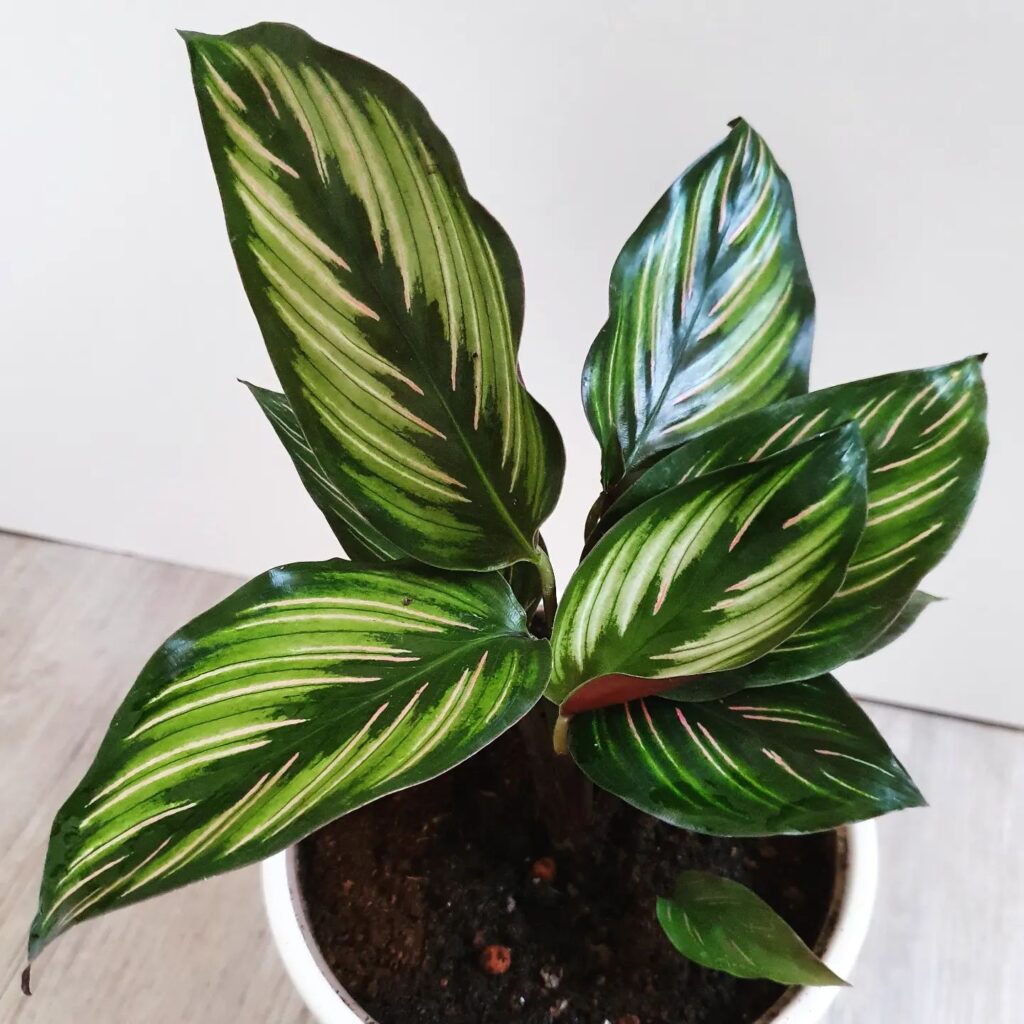
Like any other beauty star, a calathea with such a name will attract attention wherever you place it! Its oblong, narrow, glossy dark green leaves with accentuated tips have light green, silver or pink stripes in a herringbone pattern.
The erect petioles on which the leaves grow and the back of the leaf have dark purple color, which further emphasizes the light pattern on the leaf.
Calathea beauty star is a lush and dense plant that grows up to 36 inches high and 26 inches wide. New shoots develop underground directly from the rhizome root, spreading the plant.
Like other calathea plants, this one likes shady places with indirect light. Consequently, it would help not to keep it next to an unshaded west or south window. Soft light coming from the east window or indirect lighting from the north window is more similar to natural light in its original environment on the ground floor of tropical forests.
5. Calathea Ornata and Sanderiana – Pin Stripe Calathea
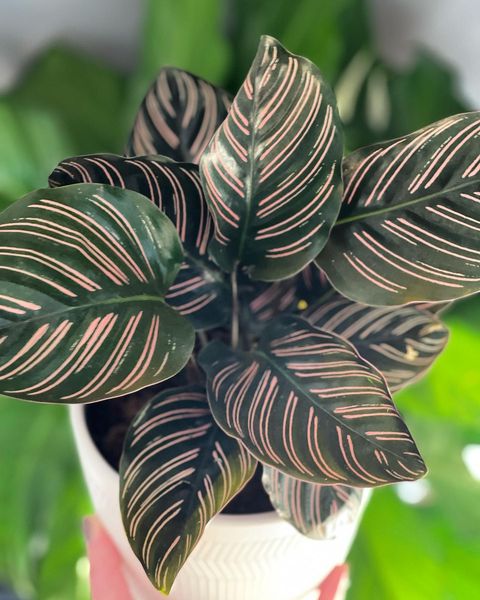
Calathea Ornata or Pinstripe Calathea are stunning foliage plants with large oval, shiny dark green leaves with a distinctive feathery pattern in vivid green color.
Its leaves grow on upright long green stems, and the reverse is reddish-purple. Young plants can have a pink hue that fades when the plant grows older. Therefore, the mature plant most often has a bright green feathering pattern.
Graceful, light green stripes on the leaves are the reason for the nickname of this plant – the Pinstripe plant.
The variety of Calathea Ornata Sanderiana has an almost identical pattern on the leaves. The main difference between these two types of calathea is the size of the plant.
Namely, Sanderiana is one of the largest indoor calathea varieties that grow up to three feet in height and one and a half feet wide, which certainly makes it a gorgeous statement houseplant with a notable exotic effect.
6. Calathea Makoyana – Peacock Plant
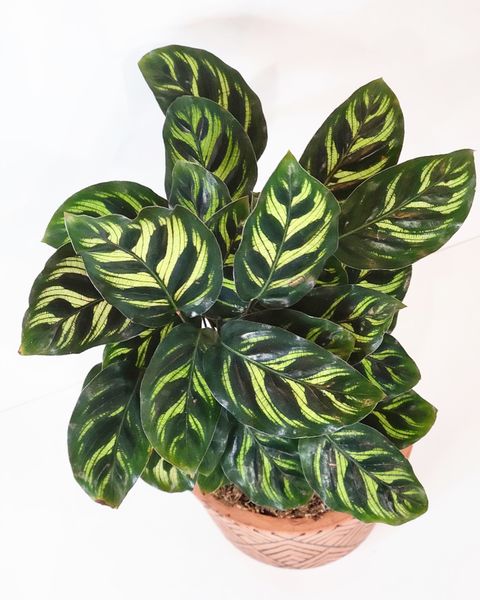
Calathea Makoyana, also known as the Peacock plant and Cathedral window, is another lavishly decorated, breath-taking calathea plant, and many will argue that it is one of the most beautiful calathea species.
Although everyone has his favorites, it is fair to say that Calathea Makoyana is a unique sight of elegance and color, just like a peacock’s tail! Its light green leaves, 10 to 12 inches long, have dark green markings arranged from the central leaf vein towards the bright edges of the leaf.
In addition, the new variegated small green leaves are rolled up, so their pinkish-maroon or purple undersides are visible, which further enhances the coloring effect of the plant.
Like most calathea species, Calathea Makoyana grows up to two feet tall and one and a half feet wide and prefers moderate-lit spots with bright indirect sunlight and 60% humidity in its surroundings.
7. Calathea Musaica – Network Plant
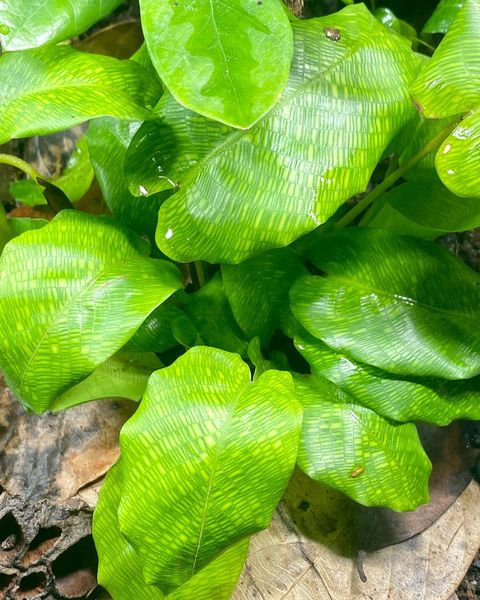
Calathea Musaica is a unique species and is easy to distinguish from other calathea varieties. Namely, its vibrant, medium-green leaves on the upper surface are entirely covered with a network of tiny yellow-green lines that stand out, especially when the mild morning or late afternoon sun touches its leaves.
Due to its discreet variegation, Calathea Musaica may not be as eye-catching as other types of prayer plants, but it compensates it with somewhat modest growing requirements.
The musaica calathea plant adapts better to dry room air and tolerates 50% air humidity which is not difficult to achieve by regular spraying the leaves. In other words, the Calathea Musaica plant will not show deformation of the leaves due to lack of moisture and when this level is far below the ideal 80%.
RELATED: Calathea Rufibarba: The #1 Care, Propagation, and Watering Guide For This Fuzzy Plant
8. Calathea Veitchiana – Calathea Roseopicta
Among the popular calathea species is the gorgeous Calathea Veitchiana, often called Calathea Roseopicta and Rose Painted Calathea. And indeed, few plants can boast of such lavishly painted leaves as Roseopicta.
Calathea Medallion
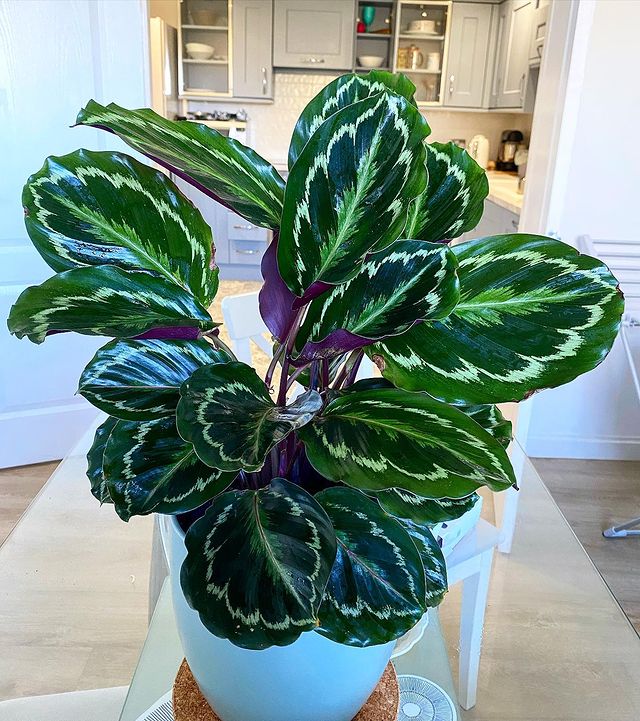
It is almost impossible not to notice its large elliptical, broad dark, deep green foliage banded with creamy-white, emerald green, or pink midrib, irregular line with an ombre effect towards the dark green ends of the leaf.
In addition, the deep red-purple becks strongly contribute to this actual festival of colors and patterns.
You could find several varieties of Rose painted calathea with midrib lines and patterns in different colors. Usually, each one has a nickname. For example, the Calathea Medallion has shades of green, Calathea Dottie has shades of green and pink, and Calathea Eclipse has light pink, pink, green and white patterns.
Calathea Dottie
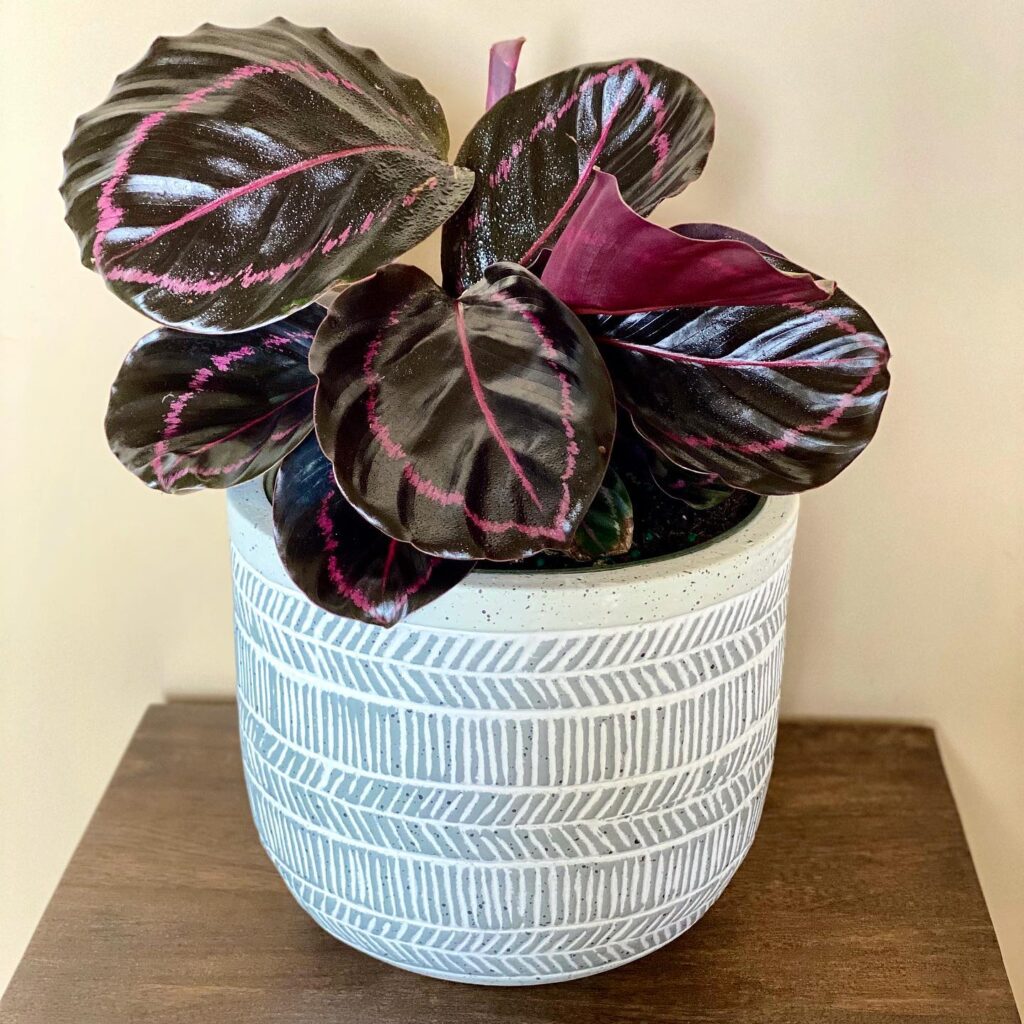
But regardless of the varieties, all Calathea Roseopicta plants are clump-forming species, which grow up to one and a half feet tall and two feet wide, prefer bright indirect light, high humidity and moderately moist soil.
9. Rattlesnake Plant – Calathea Lancifolia
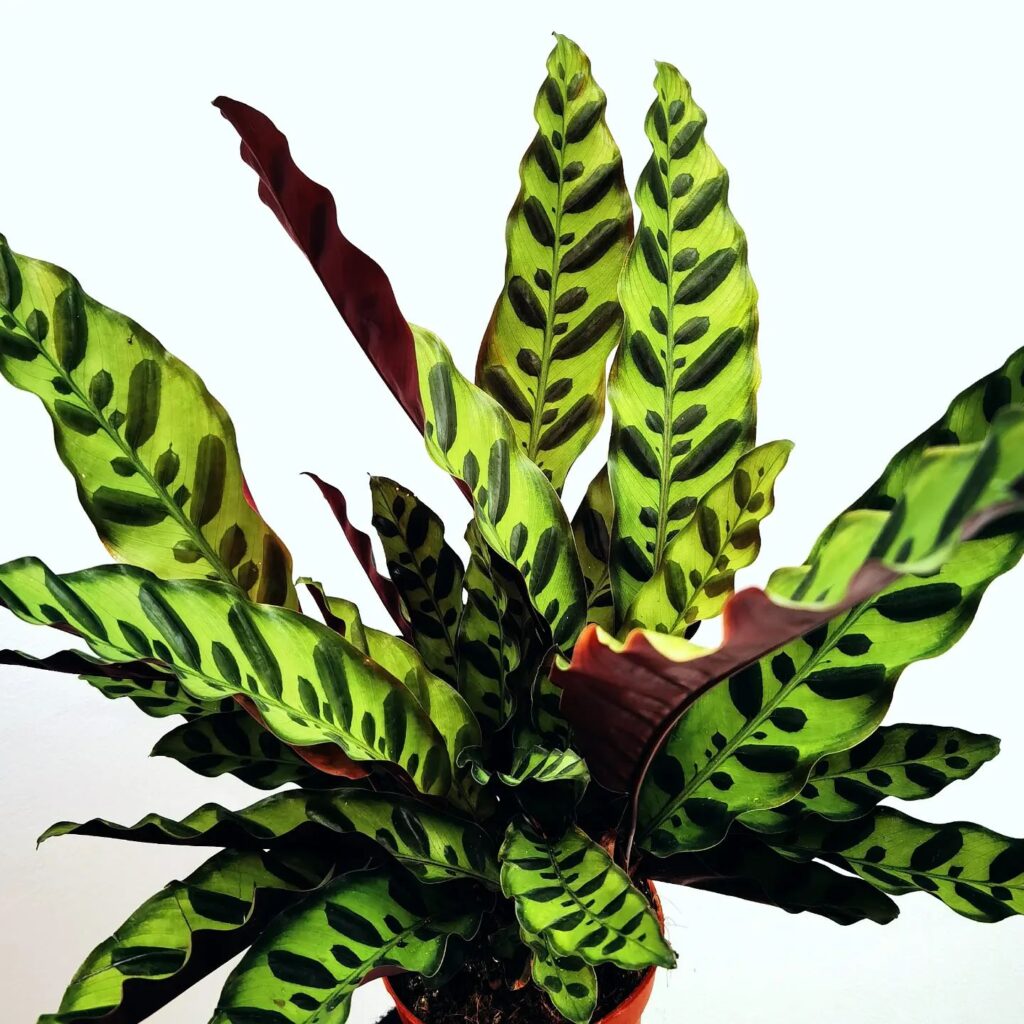
Native to Brazil, the Rattlesnake plant or Calathea Lancifolia plant got its common name because of the snake-like dark green strokes on its long, narrow light green leaves with slightly wavy edges.
Calathea lancifolia plants grow up to 30 inches tall, and shiny lance-shaped green foliage with purple backs appear on short erect stalks. Since the leaves are upright, often fan-arranged, you don’t have to wait until the evening for the plant to fold the leaves to see the lovely purple undersides.
In nature, the Rattlesnake plant blooms with small yellow flowers, but indoors it rarely happens. Yet, this elegant and erect plant of impressive decorativeness is one of the most popular types of calathea plants.
Apart from its beautiful appearance, the reason for its popularity lies in its relatively simple cultivation and better resistance to unfavorable growing conditions.
However, this does not mean bringing the plant into the house and expecting it to adapt. Like all other calathea plants, this one needs moist air, heat, and indirect lighting, except that this plant reacts less dramatically and tolerates unfavorable growing factors for longer.
RELATED: Nature is Sweet As! 10 Different Types Of New Zealand Trees
10. Calathea Rufibarba – Furry Feather Calathea
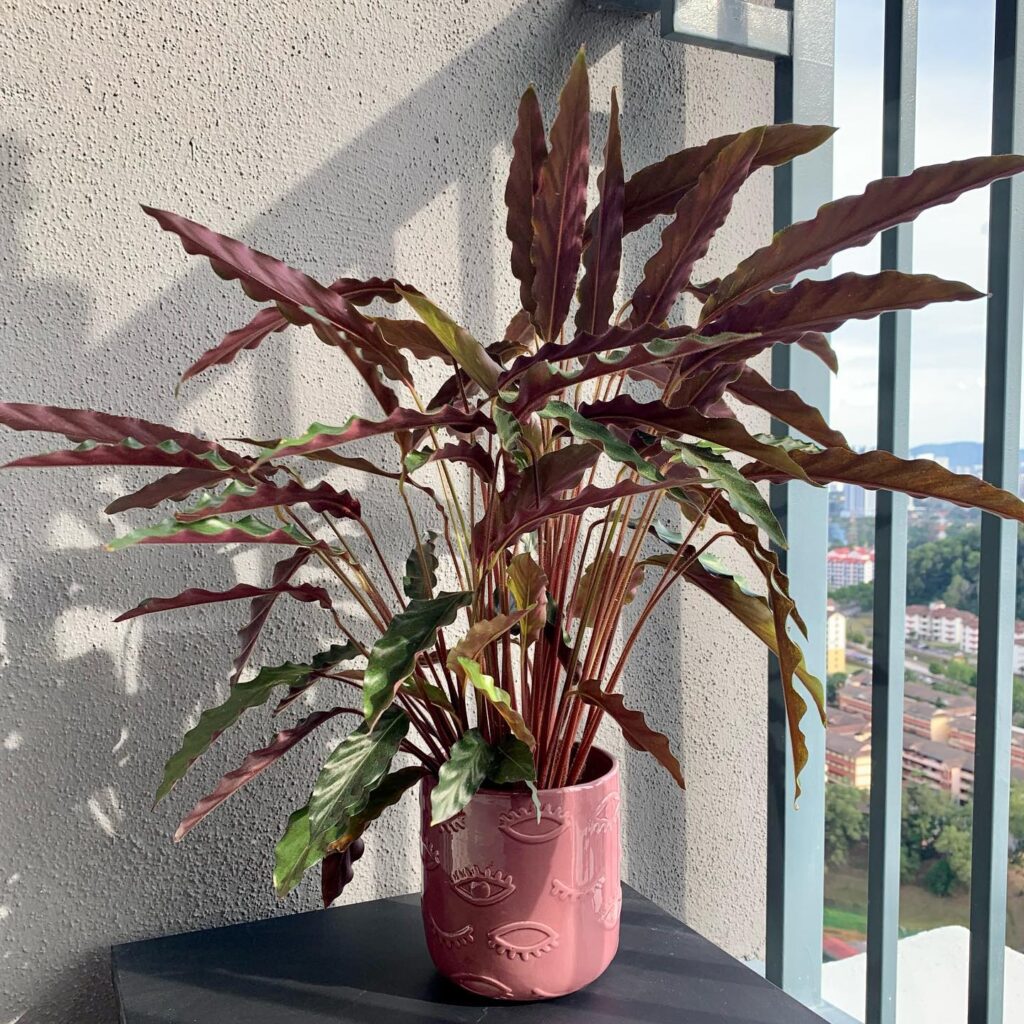
At first glance, Calathea Rufibarba looks like the Calathea Lancifolia plant, and it is not difficult to confuse. Namely, both of these plants have atypical, unusually narrow and elongated dark green leaves with wavy edges and purple undersides.
However, Calathea Rufibarba leaves are subtle, waxy and almost monochromatic. Unlike most other calathea plants, the reverse of the leaf and the stems are covered with fine hair, and because of that, the plant is sometimes called Velvet Calathea or Furry Feather Calathea. In addition, the velvety purple undersides make the Calathea Rufibarba unique and easily recognizable among other calathea types.
Calathea Rufibaraba is more extensive than other types of calathea and, in suitable conditions, can grow up to three feet in height, forming a dense cluster of leaves.
Like most other species of calathea, Calathea Rufibarba is native to Brazil, where it grows in partial shade under the high tropical forests.
Therefore, it grows best in bright indirect sunlight, sheltered from direct sunlight in a room with high humidity, such as a bathroom or kitchen.
11. Calathea Warscewiczii- Calathea Jungle Velvet
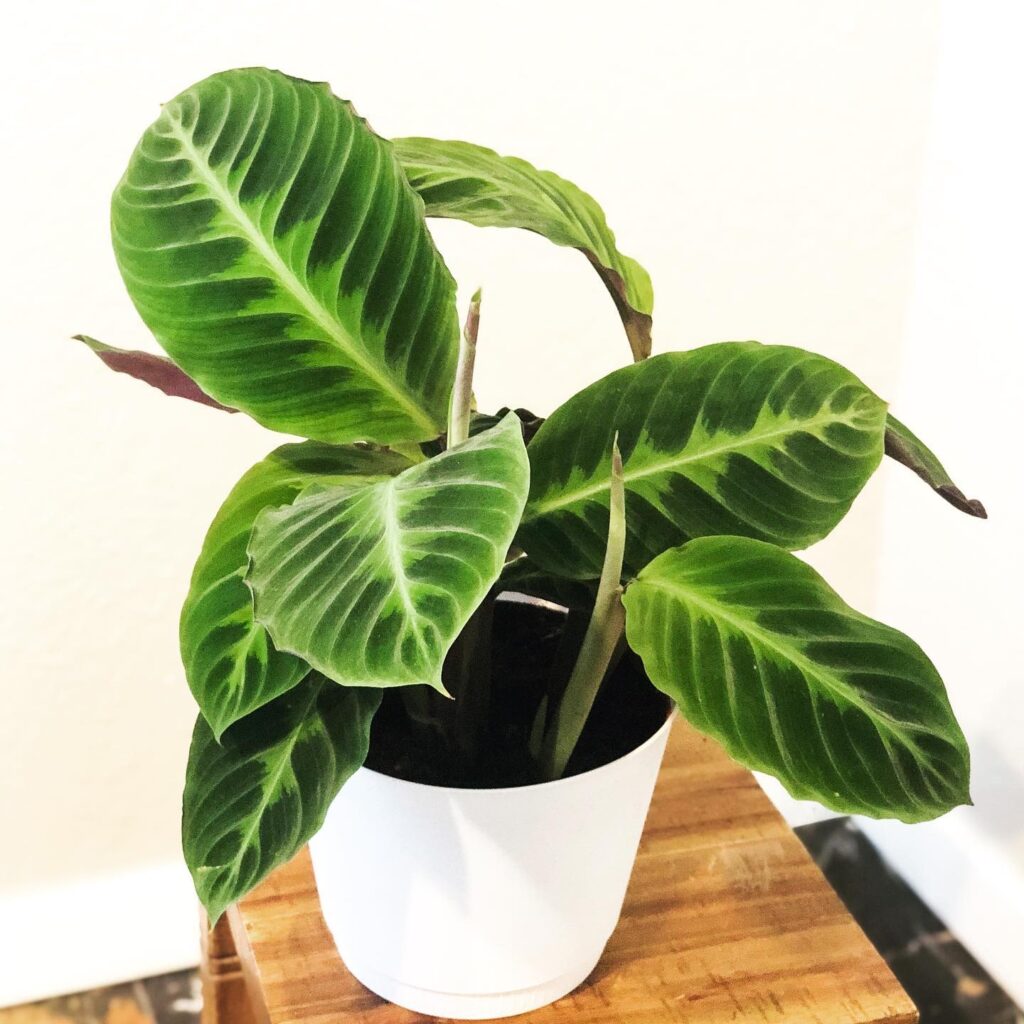
Unofficially known as Velvet Jungle Calathea, this adorable calathea plant with the hard-to-pronounce botanical name Calathea Warscewiczii is a species with soft, velvety leaves in two green tones.
Its sophisticated deep green foliage has striking light green stripes along the central and lateral veins, bright green edges and purple becks.
Although it belongs to the group of so-called prayer plants, Velvet Jungle Calathea does not have as dramatic leaf movements as many other species in the Marantaceae family.
However, as the level of illumination changes during the day, the lovely Jungle Velvet plant reacts with slow but constant movements, so it seems to rearrange itself at all times. In other words, whenever you look at it, it looks different!
This plush calathea variety with green top and deep purple becks is quite a large plant, so mature specimens can reach more than three feet in height and just as much width. Therefore, provide it with enough space next to the east or north window with a lot of indirect light.
The plant likes high humidity, even up to 90%, and therefore it is an ideal plant for a greenhouse. It prefers moist but not soaked soil, so water it regularly with distilled, stagnant water or preferably rainwater.
12. Calathea Crocata – Eternal Flame Plant

Although all calathea plants are bloomers, most have inconspicuous tiny cream or yellow flowers and rarely bloom indoors. The exception is Calathea Crocata, or the Eternal flame plant offering a unique flower show with a gorgeous leaf display.
The flowers grow on erect stems above a rosette of shiny, metallic, slightly wrinkled dark green foliage with a maroon-purple back. The alluring orange-yellow bracts in cup shape surround the tubular flowers with rose-red sepals, making them hard to spot. This magic floral performance is most intense in the summer and lasts for two to three months!
The lovely plant is native to Brazil and other countries of tropical America. Still, due to the destruction of its natural habitat, Calathea Crocata, once the prevalent calathea plant, is tough to find in nature nowadays.
As well as other calathea varieties, the Eternal flame plant dislikes direct sunlight and prefers indirect light, high humidity and uniform temperatures throughout the year.
It blooms more abundantly and grows more densely if you provide it with a few hours of bright indirect sunlight in the morning or afternoon.
RELATED: Calathea White Star: The #1 Care, Propagation, and Watering Guide
13. Calathea Concinna
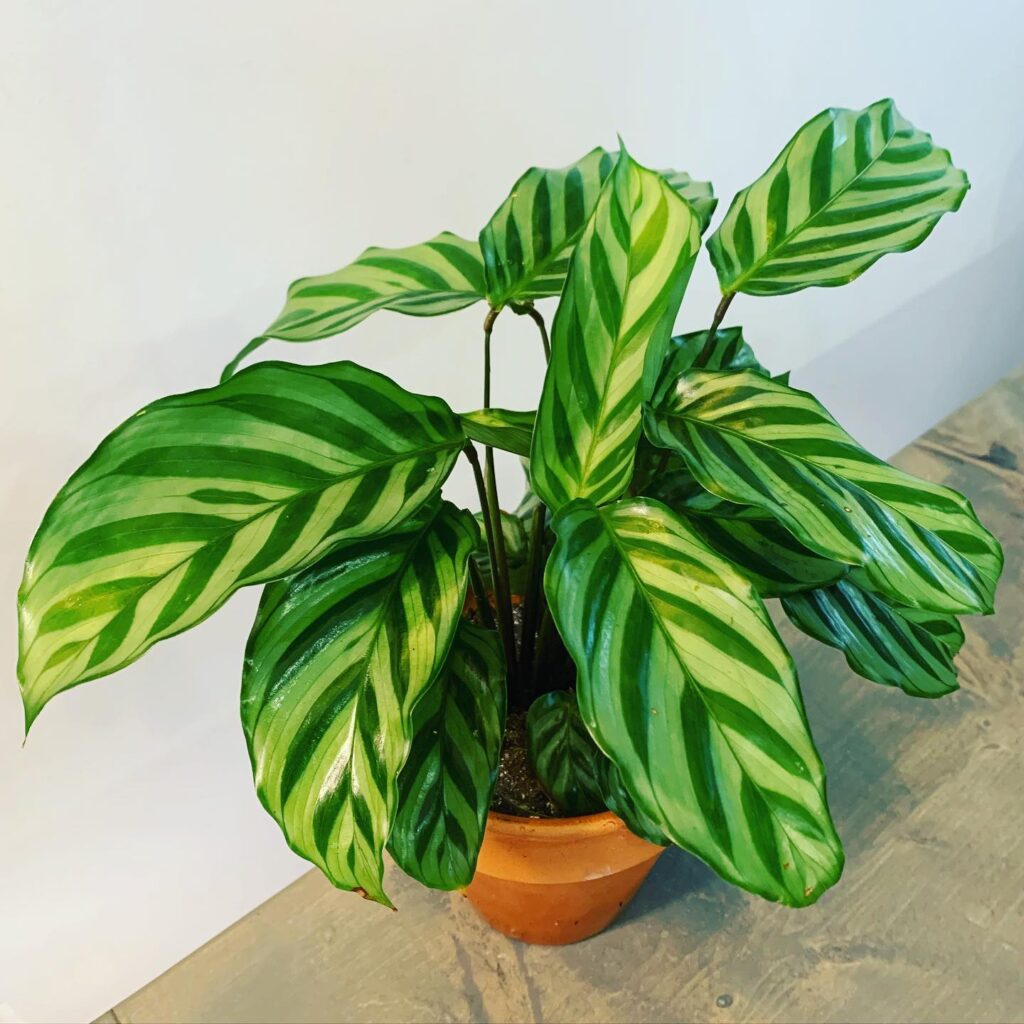
Calathea Conncina or Calathea Leopardina differs from other plants of this genus in that both the face and the back of the leaf are green. The upper side of the long, oval leaf is light green with dark green spots or spotted stripes resembling the leopard pattern.
It is a great table plant for your living room or office since it doesn’t grow more than two feet in height and width rates.
It is more resilient and less demanding than other varieties, but it still needs conditions similar to those in its natural environment in the rainforests of tropical America. It means indirect light, moist soil and increased humidity in the air.
Regular misting the leaves with lukewarm stagnant water usually solves the humidity issue and prevents crispy, brown leaf tips.
14. Calathea Majestica – White Star
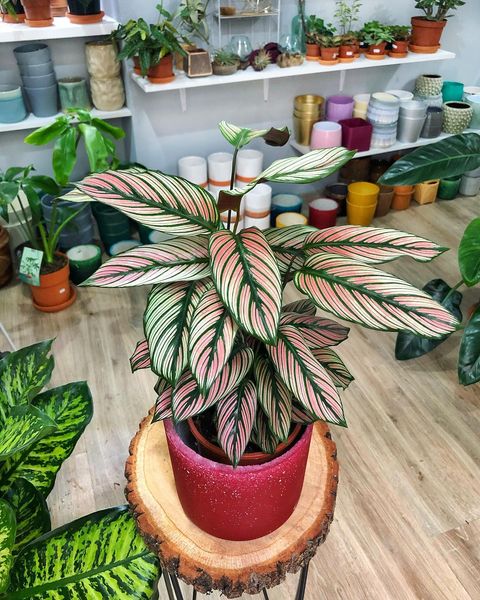
Calathea Majestica is a cultivar of Calathea Ornata, a Pinstripe calathea plant. Both calathea varieties have dark green feathery veins on a light background of oval leaves on long stems and light pink leaf reverse.
Yet, Calathea Majestica has multiple stripes that cover almost the entire leaf.
The noticeably elegant Calathea Majestica grows two feet in height, and the neatly arranged leaves at different angles give the whole plant an irresistible charm.
It requires similar growing conditions as other calathea plants, which means that you should pay special attention to moisture and adequate lighting.
Although calathea is generally considered a plant that tolerates low light conditions better than some other tropical plants, you should provide it with at least a few hours of bright indirect sunlight for vivid healthy leaves. Lack of light causes pale leaves, and too much light quickly burns delicate foliage.
15. Calathea Maui Quin
Calathea Maui Quin is a hybrid cultivar you can’t often see because it is more sensitive than most other calathea species and reacts more dramatically to adverse growing factors.
The plant has dark leaves with light markings in the middle, along the central vein, that look like hand-painted brush strokes and the brown-purple backs of the foliage.
Calathea Maui Quin can grow more than two feet in height and width, creating impressive three-foot-high clumps in proper conditions.
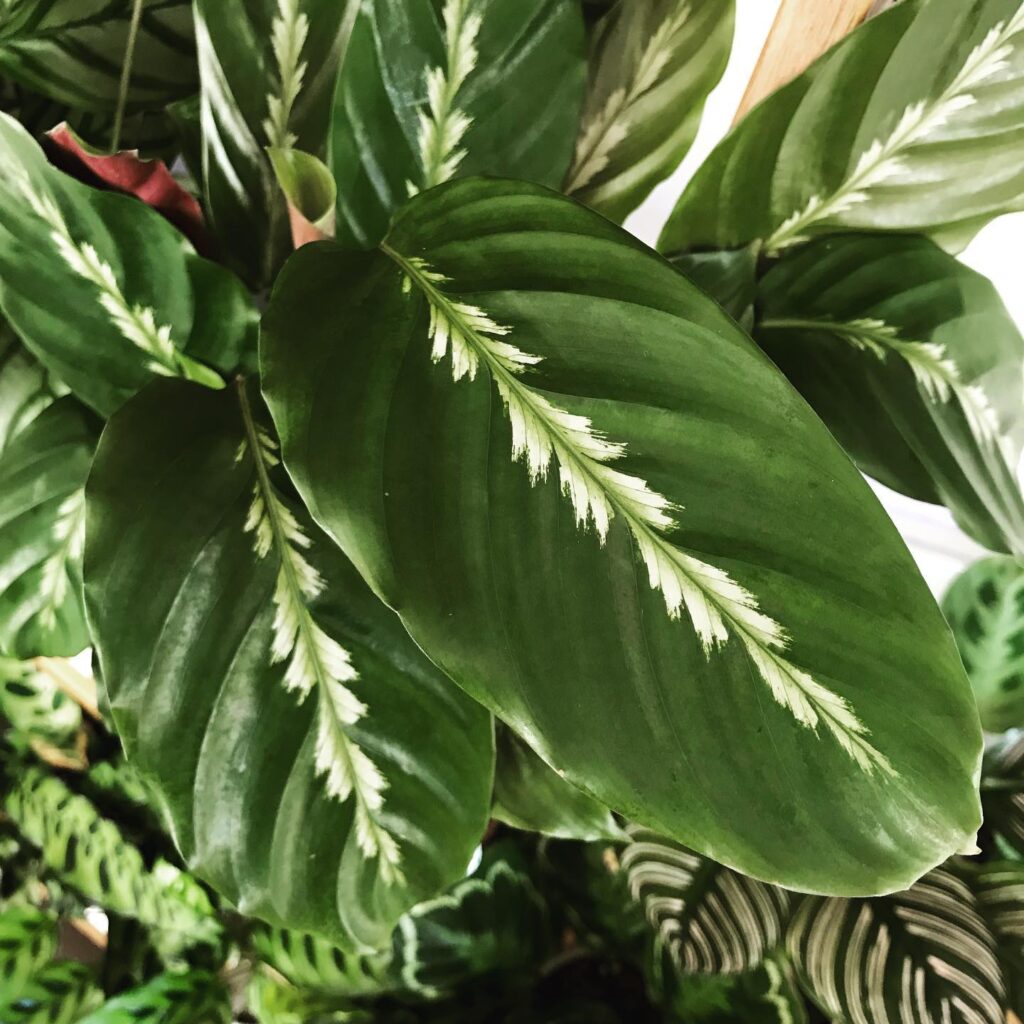
The plant is also sensitive to cold air currents and temperature oscillations and quickly decays if the space in which it resides does not have enough moisture.
Because of all this, this is not a plant for beginners, and it is grown mainly by collectors or passionate lovers of calathea plants who have gained experience growing some less demanding varieties.
Frequently Asked Questions
What is the rarest calathea?
Calathea White Fusion and Calthea Maui Queen are the plants that are the rarest among the calathea varieties.
What is the easiest calathea to grow?
Calathea Concinna, often called Freddie and Calathea Lancefolia, is less demanding and more tolerant to different surrounding conditions.
Can calathea grow outdoors?
Calathea, regardless of variety, is not resistant to frost and is primarily an indoor plant. However, in warm regions, (USA Climate Zone 11) can grow in a garden in a shaded area.
Can I put my calathea outside in the summer?
The plant can spend the summer outside on the terrace or in a shady spot. However, as soon as the night temperature drops below 55 F, bring it into the house.
Is calathea toxic to pets?
All calathea plants are pet-friendly and do not contain toxic substances that cause serious health problems.
Editor’s Recommendations
After knowing the types of calathea, check out our other plant care tips:
17 Amazing Types Of Amazon Plants (Including Photos)
21 Types Of Fuchsia Plants & Reasons Why Fuchsia Plants Are So Popular (With Pictures)







